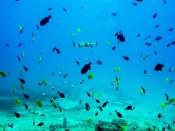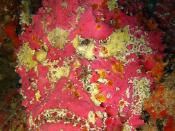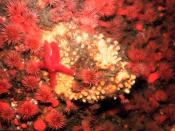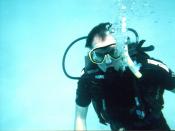As the sun rises over the tepid Indian Ocean and the first rays of sunlight touch down on the small village of Sodwana Bay the first of the fishermen clambered up onto there large fishing vessels, then embark for a long and drawn out boat ride to get to their destination which is an extensive 45 miles out to sea. At the same time an enthusiastic group of divers depart on a 8 mile trip to a captivating reef inside the bay.
As the divers plunge into the dark blue crystal clear water they are almost immediately greeted by a spectacular shoal of hundreds of king fish which resemble the tuna. These majestic King Fish are a deep turquoise colour with a dark blue line running down the length of their body. Their movements are all syncronised as if they were one whole fish and are all as swift as a dolphin.
The divers remain at this level to admire these awesome creatures of the depths. Once again the divers descend down to the reef which is roughly 20 meters below the extensive surface of the ocean. The divers now adjust there buoyancy so they are in equilibrium. They start investigating the reef. Nothing down there resembles anything like what's on the surface of the earth and has its own atmosphere. Some people even call this the ocean "The Planet Ambience". Everything is strange but yet so beautiful. The structure of the reef itself is breathtaking with huge pinnacles reaching up like fingers towards the surface; it's almost as if they are in need of the precious air that we humans require to survive. There are many overhangs and large caves which harbour marine life, through every cave or overhang there is a possibility of danger in the form of monstrous sharks with ragged teeth and stream lined bodies or a sting by a stone fish which could be fatal. These dangers still do not detour us from this underwater haven. Some of the creatures that live in this underwater paradise are so well camouflaged that the divers swim passed them not noticing the strangeness and weirdness of their beauty.
One of these creatures is the octopus, which can change the texture and colour of its body to match its surroundings. If this does not work and the octopus feels threatened, it will squirt a viscous black ink so that it can escape. Finally if the ink does not work, it can fit through a hole or crack that is only one tenth of its size due to the fact that this mollusc has no skeleton.
Some of the corals on this reef are so colourful that it looks like they have been taken out of a small child's colouring book and some of the corals are structured like something that has come off one of the planets. To cogitate that there is no sound under the sea would be a mistake because there are many animals that communicate through this medium called the ocean. For example, most of the mammals that live in the sea like the dolphins and whales use their very own sonar, like that of the submarines to communicate.
Then you get all the herbivorous animals that graze and nibble on the reef and eat the coral - they themselves make quite a pandemonium.
The divers cannot survive for long under the ocean due to there breathing apparatus, which can only sustain them for 30 to 40 minutes. They have to surface much like the whales, dolphins and turtles that also need that precious air. Once again the divers clambered up onto their boat and prepare for the 8 mile ride back to the beach, where they will warm up and get their air cylinders filled. They will get ready to dive one of the many other spectacular reefs situated in this radiant bay.
"If adventure has a final and all-embracing motive, it is surely this: we go out because it is our nature to go out, to climb mountains, and to paddle rivers, to fly to the planets and plunge into the depths of the oceans... When man ceases to do these things, he is no longer man." - Wilfrid Noyce.
This is how some people live "Under African Skies."





